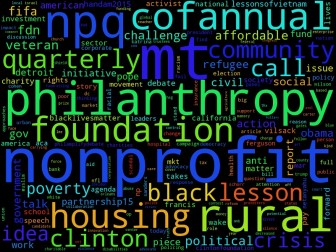It is not hard to find daily newspaper examples of nonprofit and foundation abuses sullying the charitable sector and a concomitant reluctance of nonprofit leadership institutions to say anything critical in other than the broadest, least specific terms possible. But a notable exception to this was the pledge by the Council on Foundations a couple of years ago in the wake of the Getty Trust scandal in Los Angeles, to speak out against foundation abuses wherever they might be, whether brought to the Council for action or simply stumbled across by newspaper-scouring COF staff.
How ironic to discover the Council’s choice of a conference site was constructed on an infrastructure of charitable abuses, all passing by the Council without a peep of acknowledgement of criticism then or now.
A nonprofit blogger or two bemoaned the choice of the National Harbor mega-development in Prince Georges County, Maryland, as the site for the recent annual meeting of the Council on Foundations. For a sector supposedly attentive to social and environmental issues, commentators indicated that the lavish National Harbor development represented an assault on environmental protection, community development, and smart growth, a glass and brick avatar of bloated urban sprawl to serve the rich.
The isolated hotel/conference location in what used to be Oxon Hill, Maryland, in the nation’s largest black suburban county, was selected by the Council, ostensibly, because there wasn’t a place quite large enough for the 2,900 or so conference participants. Hardly. The mammoth inner city Washington DC Convention Center is not quite as upscale as this Disney World-like upscale entertainment and hotel complex. With the ubiquitous Council-provided street-entertainment and hors d’ouvres at National Harbor, it seemed like conference goers were going to be assaulted by Mickey, Goofy, and Donald characters and dragged off to Magic Mountain.
As important as the supposed foundation attention to smart growth and environmental protection is the philanthropic underpinning of the National Harbor development: an all-too-common scandal of philanthropic accountability, political machinations, and self-interested grantmaking, none of this ever acknowledged by or commented on by the Council on Foundations. Commenting on the development’s sense of philanthropy, Washington Post columnist suggested that one of the development’s streets ought to be called “Sleazy Way.”
Sign up for our free newsletters
Subscribe to NPQ's newsletters to have our top stories delivered directly to your inbox.
By signing up, you agree to our privacy policy and terms of use, and to receive messages from NPQ and our partners.
The developer of National Harbor, one Milton V. Peterson, created a $3.5 million charitable fund for grantmaking to the Prince Georges County community and the larger Washington DC metropolitan area. It’s not an uncommon practice for developers whose billion dollar projects need community support for zoning and building permits and so much more. In this case, in return for millions in taxpayer-financed road and sewer improvements from the County, Peterson pledged $350,000 a year for 10 years for “community project”.
The money that Peterson set aside for the National Harbor Community Outreach grants fund doesn’t even register as pocket change for a development like this one. But pocket change to Peterson is pretty influential among Prince Georges County politicians and their affiliated nonprofits. The operations of the fund are a litany of bad practice:
- The County Executive, Jack Johnson, embroiled in a reelection campaign, personally delivered grants to politically powerful church leaders, including some that had never requested the moneys (Washington Post, April 15, 2007)
- A County Council member, also up for reelection, was involved in delivering unrequested grants to youth organizations in PG County (Washington Post, April 15, 2007)
- Thousands of dollars of grants were awarded to groups that apparently never received them or in some cases had never been contacted by the fund in the first place, including Christmas in April (Washington Post, May 6, 2007, April 15, 2007)
- A private school—the only private school assisted by the fund–and a Brownie troop attended by the chair of the grant committee (a confidant and political contributor to the County Exec) got $30,000 (Washington Post, May 16, 2007)
- One group got a $10,000 grant, but couldn’t deposit it because it lacked a bank account (Washington Post, April 15, 2007)
- $25,000 went to a homeowners association in Oxon Hill, chaired by a member of the grantmaking committee (Washington Post, April 15, 2007)
- All told, at least $181,000 of the first $700,000 in grantmaking went to organizations with close ties to members of the grants committee or the County Executive (Washington Post, May 5, 2007), with little or no evidence that anyone ever thought of asking to be recused from specific decisions.
No doubt that the process has been vastly cleaned up since the fund was moved to the Princes Georges Community Foundation (an affiliate of the Community Foundation of the National Capital Region). Improvements were made such as having an application process, criteria for making awards, and a requirement that the applicants be 501(c)(3) nonprofits—and that decision-makers on the Community Foundation board, like the spouse of the County Executive, recuse themselves from votes on closely connected applicants (Washington Post, January 12, 2008).
Those sort of de minimus due diligence requirements were too late for the first two batches of National Harbor grants, but not too late for the County Executive’s reelection campaign or for the permits and public infrastructure improvements obtained by Peterson’s development. There was enough to warrant reports that the Maryland State Prosecutor’s office was taking a peek at the fund regarding potential indictments, but the PG County Exec is a very powerful guy, back in office, and despite ubiquitous reports about his political favoritism, unlikely to be tagged by the state’s legal machinery (Note: Repeated calls and e-mails from this writer to the State Prosecutor went unanswered, though spokespersons for the Office of the State’s Attorney for Prince Georges County and the Maryland Attorney General recalled the State Prosecutor’s inquiry but couldn’t recall ever having seen a wrap-up).
For the Council on Foundations, the issue is simply living up to what its leadership said it would do in 2006, that it would take action on foundation accountability issues whether they were brought into the Council as complaints or discovered by reading the press. With plans designed long ago to come to National Harbor for its mega-conference, it’s understandable that the Council might have been reticent to speak out about the National Harbor slush fund. But at the conference, maybe they could have renamed one of the by-ways in the development “Time for Philanthropic Accountability Street”.











